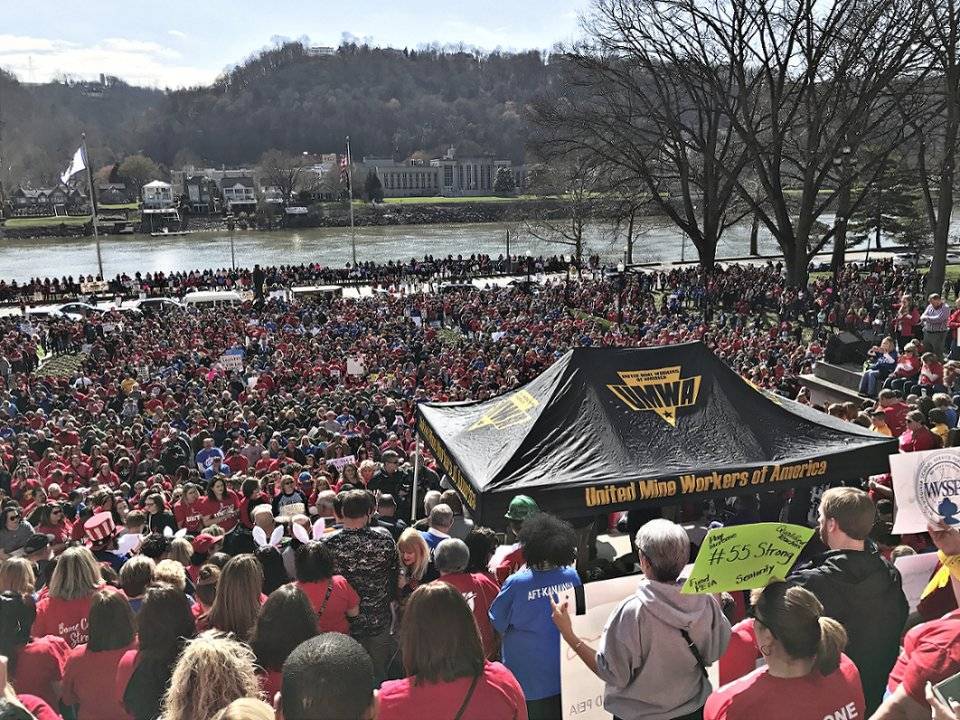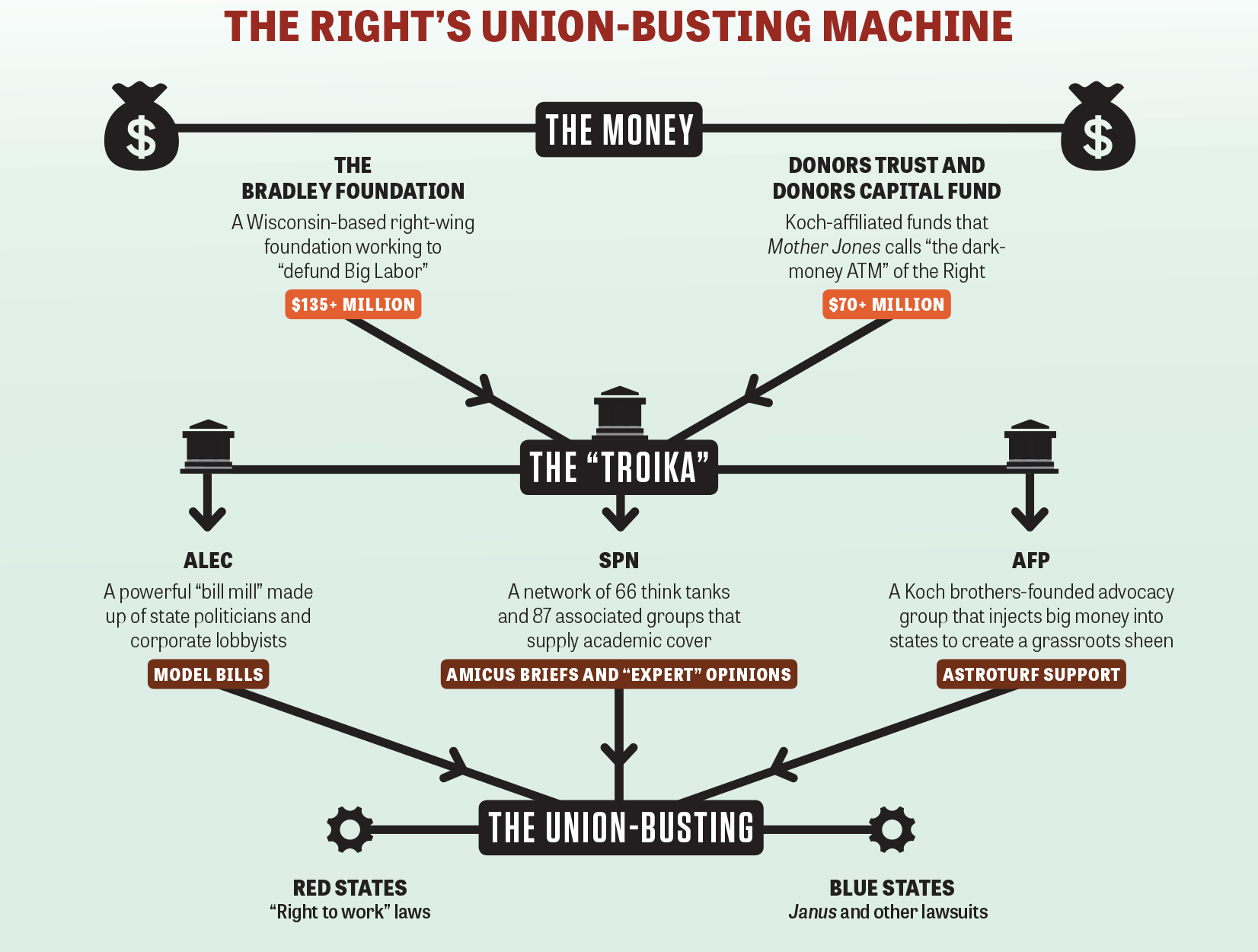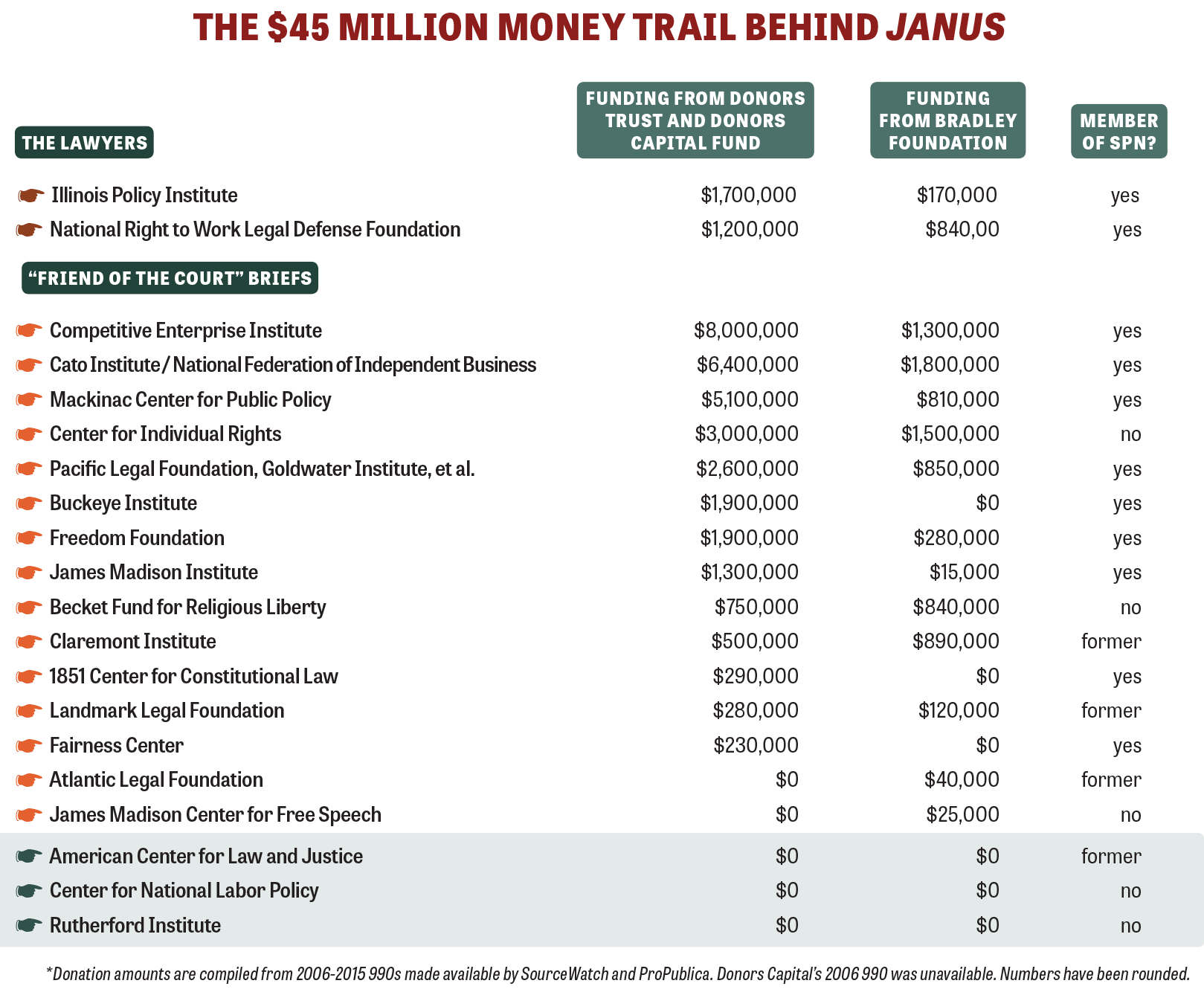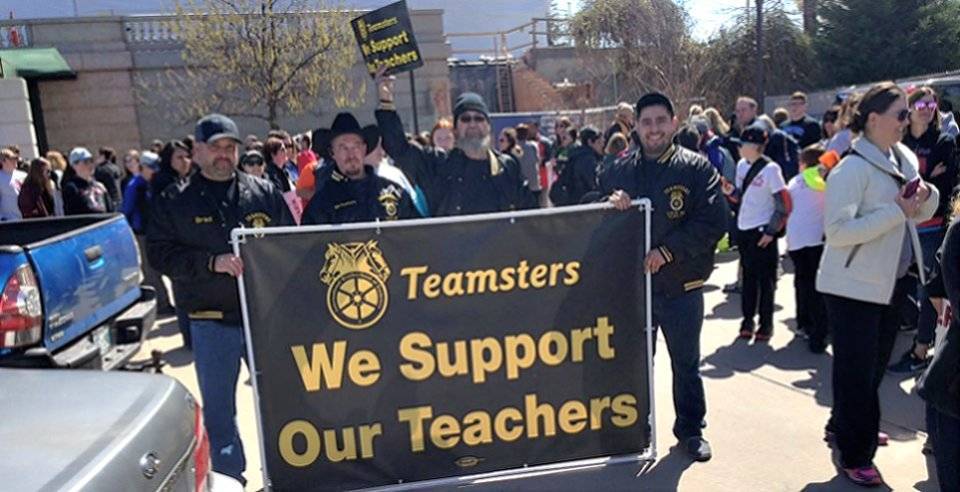Starting with this post, the next three in our “Preparing for Janus” series, will focus on the following:
- Locating the Janus case within the right’s broader, national, union-busting strategy;
- Sketching the outlines of that strategy as it is being implemented in New York State and illustrating why the work NYSUT does has been, is, and will be central to any effective opposition;
- Digging a little deeper into NYSUT’s role in protecting and preserving the health of public-sector organized labor in New York State.
As you read through these posts, we encourage you to follow the links as much as possible. They will lead you to a much fuller version of the picture we are trying to give you.
In our previous preparing-for-Janus post (the second in our series; if you didn’t read the first one, you can do so here), we outlined for you how the adverse decision we expect the Supreme Court to hand down could do significant harm to the NCCFT. Happily, and thanks to NYSUT and other public and private labor unions, some of those concerns have been addressed by the New York State Legislature, which included in its most recent budget changes to the Taylor Law designed specifically to shield unions from as much of that harm as possible.[1] A list of these changes is included in the “Labor, Ethics and Elections” section of NYSUT’s budget summary, which we posted last week. Basically, they do three things:
- Codify public employers’ obligation to deal with unions in ways that do not obstruct the unions’ ability to sign up new members, collect dues, maintain and keep track of current membership, and operate more or less as they have been till now, with the obvious exception of collecting fair-share agency fees;
- Enshrine in the law a union’s right to offer only to dues-paying members benefits and services that go beyond what is in the contract it negotiates on behalf of the bargaining-unit as a whole;
- Protect a union’s dues-paying members from free-riders by stipulating first that a union is only obligated to represent non-members in situations that involve the negotiation and enforcement of a contract and, second, that the union is not required to represent non-members in disciplinary cases where the non-member is authorized to secure their own representation.
We can, and we should, take comfort in these protections. It’s good to know that ours is, relatively speaking, a labor-friendly state, though it’s also important to recognize that this friendliness is neither guaranteed nor without cost. There are significant forces arrayed against public sector unions, and teachers unions in particular, in both the business world and in government. Defending ourselves against their attacks–one successful example of which are the changes to the Taylor Law we just discussed–requires power and influence, and power and influence cost money. The national scope and potentially devastating consequences of Janus (depending on how the Supreme Court rules, those changes to the Taylor Law could be rendered moot), highlight not only how important that money and influence is, but also the scale at which we will need to be able to wield it, a scale which it is unlikely any single union local would ever be able to afford.
James E. Freeman and Peter Kolozi, professors of political science at Bronx Community College, summarize the situation in New York State in an article they wrote for Thought & Action, a journal published by the National Education Association:
Businesses and their friends in government at all levels have nearly destroyed private sector unions and, as a result, private-sector pay has stagnated. At the same time, anti-tax Democrats such as Cuomo and his allies in both parties provide generous tax breaks to New York’s wealthiest citizens and its private corporations, draining the state’s coffers and squeezing budgets at the state, county, and municipal levels…[making it] too easy to point the finger at public employees instead of private corporations as the culprit in New York’s budget woes.
This same dynamic, of course, has been playing out across the country, making it no accident that public sector unions have increasingly come under attack. The Janus case–precisely because it is being decided by the Supreme Court and will therefore have, by definition, an immediate national impact–is only the most recent and potentially devastating form this attack has taken. In thinking about how to respond to Janus, however, whether at the local, state, or national level, it’s important not to focus too narrowly on either the plaintiff, Mark Janus, or the specific issue the case is about: the constitutionality of the fair-share agency fee. Important as that fee is, eliminating it is really only a tactic, part of a much larger strategy that has been orchestrated by a highly organized, very well-funded, cohesive, and committed group of right-wing organizations. The goal of this strategy is not only to implement a deeply worker-hostile vision of labor relations in the United States, but also to move our national politics in profoundly regressive directions.
Indeed, according to documents leaked in 2016 from one of those organizations, the Bradley Foundation, this coalition has been working for at least 15 years, in the words of In These Times writer Mary Bottari “to build infrastructure in battleground states to support the Republican Party and tear down unions.” To get the full picture of who is in this coalition and how it has worked, we encourage you to read Bottari’s article in its entirety. Here, we’re just going to sketch the coalition’s broad outlines, from the groups that provide operational funding to those that do the organizing and legislative work of union-busting. This infographic from Bottari’s piece makes it easy to see the entire network:
That Koch brother-affiliated funds are providing cash for this attack on organized labor will come as no surprise, but it’s likely that many of us have not heard of Milwaukee’s Lynde and Harry Bradley Foundation, which has been providing the lion’s share of the funding. Together, these two entities provide the working capital for three organizations–the American Legislative Exchange Council (ALEC), the State Policy Network (SPN), and Americans for Prosperity (AFP)–each of which has a clearly defined role in achieving the coalition’s goals. Those roles are:
- ALEC: Crafting bills like Wisconsin Act 10, which has wreaked havoc on teachers unions since it was signed into law by Governor Scott Walker in 2011;
- AFP: Creating the appearance of grassroots support for coalition initiatives by funneling millions of dollars into TV ads during election cycles
- SPN: Sponsoring a network of think tanks and other groups that provide the intellectual, scholarly, and policy justification for the bills ALEC writes; the Empire Center for Public Policy in Albany, for example, about which more in our next post, is an affiliate member of SPN.
SPN-affiliated groups have played a crucial role in moving the Janus case forward and in making it seem as if the Janus plaintiffs enjoy support from a wide cross-section of groups across the country. Thirteen out of nineteen plaintiff-friendly friend-of-the-court briefs that have been filed by organizations, however, come from current or former SPN members. Seventeen of these organizations have received funding from the Bradley Foundation and/or the Koch brothers’ Donors Trust and Donors Capital Fund, as you can see in this graphic, also from Bottari’s article:
The amount of money being poured into the organizations supporting Mark Janus’ suit should make it obvious that there’s something more at stake here than the money Janus and those like him will save on fair-share agency fees. Indeed, as The Guardian revealed when it published an SPN fundraising letter first obtained by the Center for Media and Democracy, the Janus case is one component in a long-term right-wing strategy to, as SPN’s president Tracie Sharp puts it in the letter “reverse the failed policies of the American left [and] to deliver a mortal blow to permanently break its stranglehold on our society. I’m talking about government employee unions” (emphasis in the original).
We urge you to read the entire letter. Even though it deals only with SPN’s fundraising, it will give you a visceral sense of–indeed, it describes in some detail–what we’re up against: a well-thought-out, comprehensive, nation-wide, and so far remarkably effective attack on organized labor. To defend ourselves against this kind of attack, to go on the offensive when we are able, public sector unions cannot think of themselves only, or even primarily, as individual locals acting independently in the interests of their members. We need to think of ourselves as organized labor, a collective, a movement, connected to each other through our shared experience as workers, and it shouldn’t, because it really doesn’t matter whether we do that work in higher education or, for example, our county’s sanitation department.
You can see the power of this kind of movement-oriented thinking in two states, West Virginia and Oklahoma, where teachers have in recent months taken the lead in protesting, in striking against, the right-wing’s austerity-minded underfunding not only of education, but of the public sector in general. Teachers have been taking action as well in Kentucky (also here) and Arizona (also here), and now in Colorado too, but we’re going to focus on West Virginia and Oklahoma because teachers in those two states actually went out on strike.
In West Virginia, for example, careful planning led to a show of solidarity among teachers and school service workers that led to the shutdown of all 55 school districts in the state. More than that, because they made it clear that they were striking for all state workers, the teachers and service workers built important alliances with other unions, such as the United Mine Workers of America, whose officers showed up on the picket line and at rallies to offer support and solidarity. (You can read UMWA’s congratulatory press release here.)

That same kind of solidarity was on display in Oklahoma, where the Oklahoma Public Employees Association joined the Oklahoma Education Association on the picket lines and where the Teamsters not only drove shuttle vans for demonstrators, but also refused to cross the picket lines to do renovations in the state Capitol.
In the short-term, the Oklahoma strike was the less successful of the two, but focusing on short terms gains in measuring the value of strikes like this misses the point. The kinds of collective action we saw in West Virginia and Oklahoma–and, we should add, that we are seeing in Arizona and Kentucky–demonstrated not only that the right wing’s austerity-minded agenda can be interrupted, if not thwarted, but that its whole premise can be called into question when the people that agenda is designed to hurt choose to resist.
What’s going on in Arizona provides a very useful illustration. The Thomas B. Fordham Institute, an associate member of SPN located in Washington, DC, has done extensive opposition research on teachers unions, quantifying our strength on a state-by-state basis. Their report, “How Strong Are U.S. Teacher Unions?” characterizes Arizona’s as “the weakest in the nation:”
Even though bargaining is permitted, they have low membership and few financial resources. State law limits the unions’ power to strike and gather revenue, supports charter school expansion, and does not offer teachers many of the job securities seen in other states.
Nonetheless, teachers in Arizona were able to make their state government stand up and pay attention. Just a week or so ago, in fact, in response to the pressure educators have been bringing to bear, Arizona Governor Doug Dacey announced a plan to raise their pay by 20% by the beginning of the 2020 school year. A governor’s promise, of course, is not a guarantee, and teachers in Arizona are right to be skeptical, but even getting to the point where the governor felt it necessary to make such a promise does not seem like something “the weakest [unions] in the nation” should have been able to accomplish, much less to have accomplished it as quickly as they did.[2]
The job actions taken by the teachers in these four states achieved the high level of visibility they did, and made the underfunding of public education part of the national conversation in a way that it hasn’t been for a very long time, because they took action at the state level, not within their individual school districts. There are two primary reasons for this. First, in the case of West Virginia, Oklahoma, and Kentucky, teacher salaries are set by the state legislature. (There are fifteen states where this is the case.) In other words, it would not have made sense for them to strike at the local level, since their local administrations had no control over the main issue they were protesting. Second, all four of these states, including Arizona are right-to-work states. Or to put it another way, they are red states in which the right’s union-busting strategy of passing right-to-work laws has succeeded, so it makes sense that teachers in those states would take their protests to the people empowered to change those laws.
The situation in New York is very different. Our salaries, from K–12 through higher ed, are set not by our state legislators, but by the local districts or individual campuses where we work. Moreover, at least for K-12 educators, according to the NEA’s 2017 Rankings & Estimates report, New York State had the highest 2015 and 2016 average teacher salaries in the nation. We also, in those years, ranked second in terms of public school revenue per student. This doesn’t mean public school teachers in New York State earn as much as they should or that we spend as much money on our students as we should, but it does mean that the deficit educators in New York State feel has not yet reached the levels of desperation felt by our colleagues in the other states we’ve been discussing.
In addition, unlike those other states, we are not a right-to-work state. There is, in other words, no single, obvious, bottom-line, state-wide issue in which all New York educators have an equal share and around which we could rally in the same way that teachers in West Virginia, Oklahoma, Arizona, Kentucky, and Colorado have done. This doesn’t mean we don’t face serious, state-level threats. We do. The different form those threats take, however, require different forms of fighting back, which is what we will talk about in our next post.
- We wrote a brief history of the Taylor Law and why it is so important in our first Janus post. ↩
- The success teachers have been having, not only in terms of getting what they want from their state legislatures, but also in terms of their organizing power, clearly has the right rattled. The Guardian has obtained the “messaging guide” put together by SPN’s senior policy advisors outlining a strategy for how legislators and anti-union activists can undermine what the teacher’s are doing. One of those messages is that “teacher strikes hurt kids and low-income families,” a point that Kentucky Governor Matt Bevin tried to make in a way that we imagine both he and SPN might come to regret when he said, “I guarantee you somewhere in Kentucky today a child was sexually assaulted that was left at home because [schools were closed and their parents couldn’t afford to stay home from work and so] there was nobody there to watch them.” He also added that some of those children might have ingested poison or been introduced to drugs for the first time. ↩




3 Responses
Thank you for this. It’s incredibly helpful to have the enormity of the threat laid out in such detail. The reminder that we need to think of our union membership in terms of a broad coalition of organized labor – not in terms of sector or profession – if we’re going to stand a chance at fighting back is so important.
This overview is a bone-chilling, comprehensive indication of how important solidarity is and will be in the next few years. If we have differing agendas for different members of all labor unions, we’re done. As pointed out, we have to align ourselves with labor, period. One boat. One response: social justice.
I recommend that everyone read the book “Dark Money” by Jane Mayer to learn the history of the conspiracy of the wealthy in the United States against labor and the middle class. It is an eye-opener.